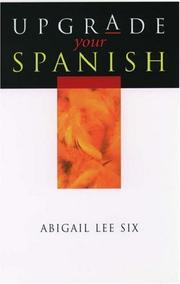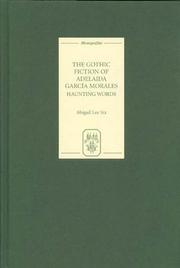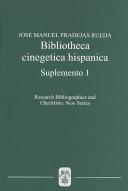| Listing 1 - 10 of 11 | << page >> |
Sort by
|
Book
ISBN: 0300047924 Publisher: New Haven, CT ; London : Yale University Press,
Abstract | Keywords | Export | Availability | Bookmark
 Loading...
Loading...Choose an application
- Reference Manager
- EndNote
- RefWorks (Direct export to RefWorks)

ISBN: 0340761865 9786612748752 1444118692 1317858867 1282748750 Year: 2014 Publisher: London, [England] ; New York, New York : Routledge,
Abstract | Keywords | Export | Availability | Bookmark
 Loading...
Loading...Choose an application
- Reference Manager
- EndNote
- RefWorks (Direct export to RefWorks)
Upgrade your Spanish is the ideal guide for students wanting a better grade in their Spanish exams. It offers a thirty day revision programme that is guaranteed to improve your results. In the countdown to exams, students should simply spend between 30 mi
Spanish language --- English --- Grammar --- Self-instruction --- Schoolbooks - Didactic material --- English.
Book
ISBN: 1282080334 9786612080333 1846154715 Year: 2006 Publisher: Woodbridge, UK ; Rochester, NY : Tamesis,
Abstract | Keywords | Export | Availability | Bookmark
 Loading...
Loading...Choose an application
- Reference Manager
- EndNote
- RefWorks (Direct export to RefWorks)
By highlighting features common to the Gothic classics and the works of Adelaida Garc©Ưa Morales, this monograph aims to put the Gothic on the map in Hispanic Studies. The Gothic as a literary mode extending well beyond its first proponents in eighteenth-century England is well established in English studies but has been strangely under-used by Hispanists. Now Abigail Lee Six uses it as the paradigm through which to analyse the novels of Adelaida Garc©Ưa Morales; while not suggesting that every novel by this author is a classic Gothic text, she reveals certain constants in the work that can be related to the Gothic, evenin novels which one might not classify as such. Each of the novels studied is paired with an English-language Gothic text, such as Dracula, Frankenstein and Dr Jekyll and Mr Hyde, and then read in the lightof it. The focus of each chapter ranges from psychological aspects, such as fear of decay or otherness, or the pressures linked to managing secrets, to more concrete elements such as mountains and frightening buildings, and to keyfigures such as vampires, ghosts, or monsters. This approach sheds new light on how Garc©Ưa Morales achieves probably the most distinguishing feature of her novels: their harrowing atmosphere. ABIGAIL LEE SIX is Professor of Hispanic Studies at Royal Holloway, University of London.
Gothic revival (Literature) --- Comparative literature --- Themes, motives. --- García Morales, Adelaida --- Criticism and interpretation. --- Plots (Drama, novel, etc.) --- Literary movements --- Revival movements (Art) --- Romanticism --- Morales, Adelaida García --- Abigail Lee Six. --- Adelaida García Morales. --- Decay. --- Fear. --- Frightening buildings. --- Ghosts. --- Gothic fiction. --- Harrowing atmosphere. --- Hispanic Studies. --- Monsters. --- Mountains. --- Otherness. --- Psychological aspects. --- Secrets. --- Vampires. --- Garcia Morales, Adelaida
Book
ISBN: 9780838757475 Year: 2010 Publisher: Lewisburg (Pa.) : Bucknell University Press,
Abstract | Keywords | Export | Availability | Bookmark
 Loading...
Loading...Choose an application
- Reference Manager
- EndNote
- RefWorks (Direct export to RefWorks)
Book
ISBN: 0838757472 0838758029 Year: 2010 Publisher: Associated University Presses
Abstract | Keywords | Export | Availability | Bookmark
 Loading...
Loading...Choose an application
- Reference Manager
- EndNote
- RefWorks (Direct export to RefWorks)

ISBN: 9781846154713 9781855661233 Year: 2006 Publisher: Woodbridge, UK ;Rochester, NY Tamesis
Abstract | Keywords | Export | Availability | Bookmark
 Loading...
Loading...Choose an application
- Reference Manager
- EndNote
- RefWorks (Direct export to RefWorks)

ISBN: 9781846154713 9781855661233 Year: 2006 Publisher: Woodbridge Tamesis
Abstract | Keywords | Export | Availability | Bookmark
 Loading...
Loading...Choose an application
- Reference Manager
- EndNote
- RefWorks (Direct export to RefWorks)
Book
ISBN: 9781138303836 Year: 2019 Publisher: New York, NY ; London : Routledge,
Abstract | Keywords | Export | Availability | Bookmark
 Loading...
Loading...Choose an application
- Reference Manager
- EndNote
- RefWorks (Direct export to RefWorks)
DescriptionSpanish Vampire Fiction since 1900: Blood Relations, as that subtitle suggests, makes the case for considering Spanish vampire fiction an index of the complex relationship between intercultural phenomena and the specifics of a time, place, and author. Supernatural beings that drink blood are found in folklore worldwide, Spain included, and writers ranging from the most canonical to the most marginal have written vampire stories, Spanish ones included too. When they do, they choose between various strategies of characterization or blend different ones together. How much will they draw on conventions of the transnational corpus? Are their vampires to be local or foreign; alluring or repulsive; pitiable or pure evil, for instance? Decisions like these determine the messages texts carry and, when made by Spanish authors, may reveal aspects of their culture with striking candidness, perhaps because the fantasy premise seems to give the false sense of security that this is harmless escapism and, since metaphorical meaning is implicit, it is open to argument and, if necessary, denial. Part I gives a chronological text-by-text appreciation of all the texts included in this volume, many of them little known even to Hispanists and few if any to non-Spanish Gothic scholars. It also provides a plot summary and brief background on the author of each. These entries are free-standing and designed to be consulted for reference or read together to give a sense of the evolution of the paradigm since 1900. Part II considers the corpus comparatively, first with regard to its relationship to folklore and religion and then contagion and transmission. Spanish Vampire Fiction since 1900: Blood Relations will be of interest to Anglophone Gothic scholars who want to develop their knowledge of the Spanish dimension of the mode and to Hispanists who want to look at some canonical texts and authors from a new perspective but also gain an awareness of some interesting and decidedly non-canonical material.
Roman gothique espagnol --- Roman espagnol --- Littérature d'épouvante espagnole --- Vampires --- Histoire et critique. --- Histoire et critique. --- Dans la littérature.

ISSN: 14769700 ISBN: 1855660970 9781855660977 Volume: 4 Publisher: Woodbridge Tamesis
Abstract | Keywords | Export | Availability | Bookmark
 Loading...
Loading...Choose an application
- Reference Manager
- EndNote
- RefWorks (Direct export to RefWorks)
This volume provides bibliographical details of over three hundred books and articles, from 1991 onwards, on Spanish, Portuguese, and Catalan hunting treatises from the middle ages to the end of the Golden Age. Each entry is accompanied by a critical commentary. The bibliography is arranged as: bibliographies and catalogues; editions and studies of the treatises (with new information on manuscripts and early printed texts), with special attention paid to manuscripts newly located in European and American libraries, and sold at auction between 1991 and 2003; and books and articles on legal, historical, lexical, literary, biological, and psychological aspects of hunting. Four indexes (authors, titles, manuscripts, and a subject index) cover not only this Supplement but also the original bibliography published in 1991.
Falconry --- Hunting --- Littératures romanes. Histoire. (Collection) --- Romaanse letterkunde. Geschiedenis. (Reeks) --- Falconry - Spain - Early works to 1800 - Bibliography. --- Hunting - Spain - Early works to 1800 - Bibliography. --- Falconry - Portugal - Early works to 1800 - Bibliography. --- Hunting - Portugal - Early works to 1800 - Bibliography.
Book
ISBN: 1784997781 9781784997786 Year: 2016 Publisher: Manchester
Abstract | Keywords | Export | Availability | Bookmark
 Loading...
Loading...Choose an application
- Reference Manager
- EndNote
- RefWorks (Direct export to RefWorks)
"A scholarly edition of three stories by Carmen de Burgos (1867-1932), also known by her pen name of 'Columbine.' De Burgos was an influential journalist, socio-political activist and key literary figure in the cultural ferment of pre-war Madrid and is currently being rediscovered, having languished in relative oblivion during the Franco years ... The book includes the unabridged texts of the stories, vocabulary, notes, chronology, bibliography, 'temas de debate y discusión,' and a critical introduction. Confidencias (1920) is the fictional diary of a young married woman describing her first adulterous relationship and exploiting the narratological possibilities of the diary form. La mujer fría (1922) is a vampire story featuring perhaps the first pitiable vampire, or at least one of the earliest examples of this type, whilst ingeniously maintaining uncertainty as to whether the protagonist is supernatural. Puñal de claveles (1931) narrates a wedding-day elopement and was inspired by a news item, the so-called 'Crimen de Níjar' of 1928. Federico García Lorca drew on de Burgos's story and the real-life crime for his Bodas de sangre, but while his play is tragic, Puñal is bathed in a golden glow of nostalgia for the author's native Andalusia and ends optimistically. This collection will be of interest to students and scholars of Spanish literature and modern literary studies"--Publisher's description.
| Listing 1 - 10 of 11 | << page >> |
Sort by
|

 Search
Search Feedback
Feedback About UniCat
About UniCat  Help
Help News
News